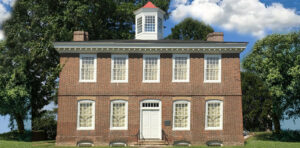William Trent House
 William Trent, with his family and eleven enslaved individuals of African descent, lived on this 1,000-plus acre plantation at the Falls of the Delaware in the colony of West Jersey, which is now the city of Trenton, New Jersey. The land on which the Trent House and the city of Trenton stands is part of the traditional territory of the Lenni-Lenape, called “Lenapehoking.” During the colonial era and early federal period, many were removed west and north, but some also remain in continuing historical tribal communities of the region. We acknowledge the Lenni-Lenape as the original people of this land and their continuing relationship with their territory.
William Trent, with his family and eleven enslaved individuals of African descent, lived on this 1,000-plus acre plantation at the Falls of the Delaware in the colony of West Jersey, which is now the city of Trenton, New Jersey. The land on which the Trent House and the city of Trenton stands is part of the traditional territory of the Lenni-Lenape, called “Lenapehoking.” During the colonial era and early federal period, many were removed west and north, but some also remain in continuing historical tribal communities of the region. We acknowledge the Lenni-Lenape as the original people of this land and their continuing relationship with their territory.
Born in Scotland, William Trent immigrated to the American colonies in the early 1690’s and embarked upon a successful career as a Philadelphia merchant. He traded mainly with Great Britain and with the other American colonies and participated in the slave trade, buying and selling enslaved people in the West Indies and in the North American colonies.
In 1714, Trent purchased a large tract of land in central New Jersey from the initial English colonist, Mahlon Stacy, and built a grand country residence in 1719. In 1720 Trent laid out a settlement surrounding his residence and in 1721 Trent, his family, and the enslaved members of his household moved to the home from Philadelphia. Trent continued his active civic life in New Jersey, serving in the Assembly and as the Chief Justice. The city of Trenton takes its name from “Trent’s Town,” the area around Trent’s home.
The house itself is a large, imposing brick structure, built in the newest fashion of the time, with an “allee” of English cherry trees leading from the entrance down to the ferry landing on the river. Nearby, there were numerous outbuildings, orchards, and fields as well as grist, saw, and fulling mills along the Assunpink Creek.
